Strategic Planning for the Hospitality Industry - Hilton
VerifiedAdded on 2023/01/18
|10
|3617
|24
Report
AI Summary
This report delves into strategic planning within the hospitality industry, focusing on the American multinational hotel company, Hilton. It critically analyzes the components impacting successful strategy implementation on business functions, emphasizing leadership, structure design, information systems, and human resources. The report evaluates various performance metrics, including critical success factors, key performance indicators (KPIs) like quantitative, directional, actionable, and qualitative indicators, and the balanced scorecard system, to assess the effectiveness of business strategies. Furthermore, it provides a critical evaluation of key elements for managing strategic change, ensuring a comprehensive understanding of strategic planning in the hospitality sector.
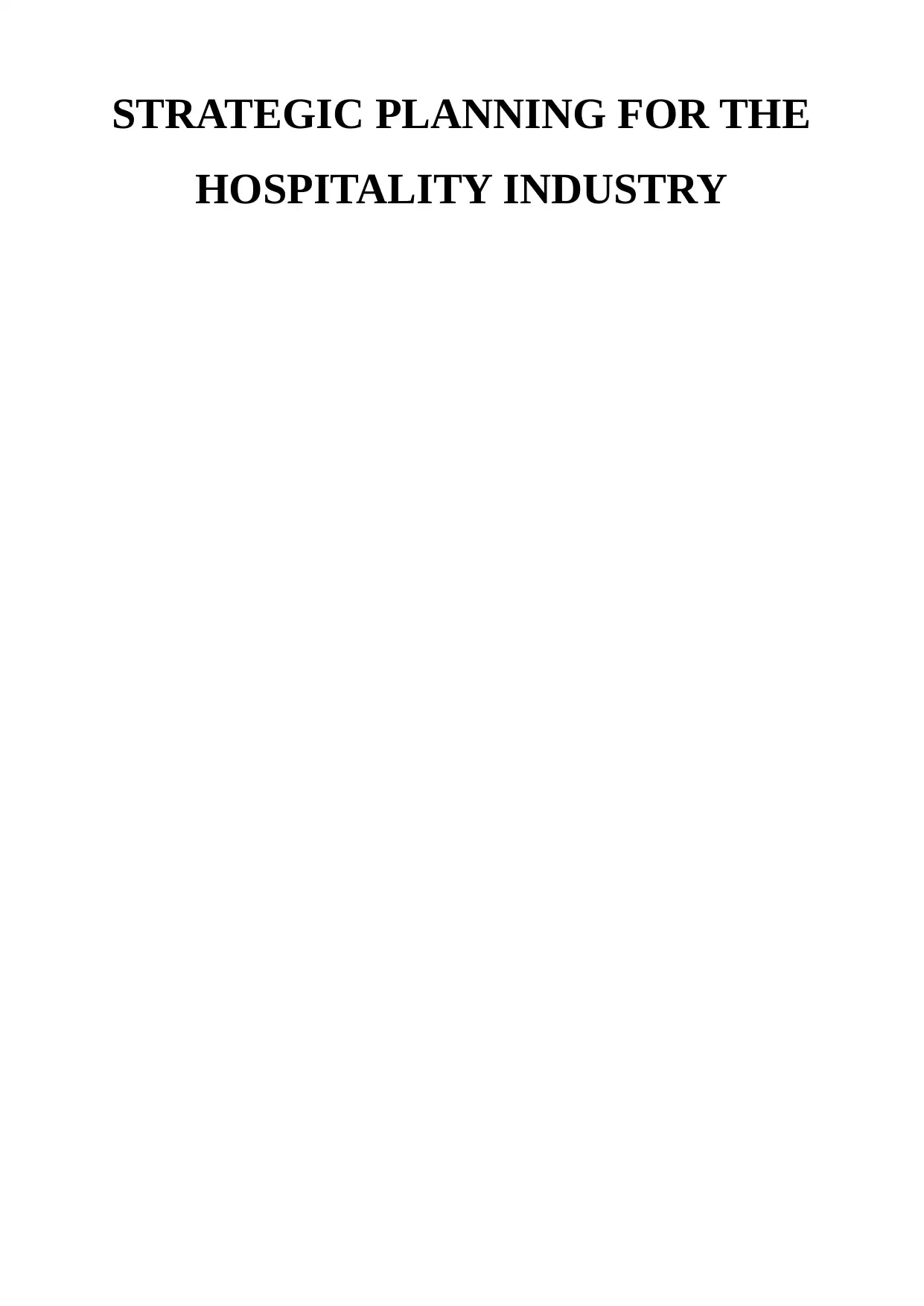
STRATEGIC PLANNING FOR THE
HOSPITALITY INDUSTRY
HOSPITALITY INDUSTRY
Paraphrase This Document
Need a fresh take? Get an instant paraphrase of this document with our AI Paraphraser
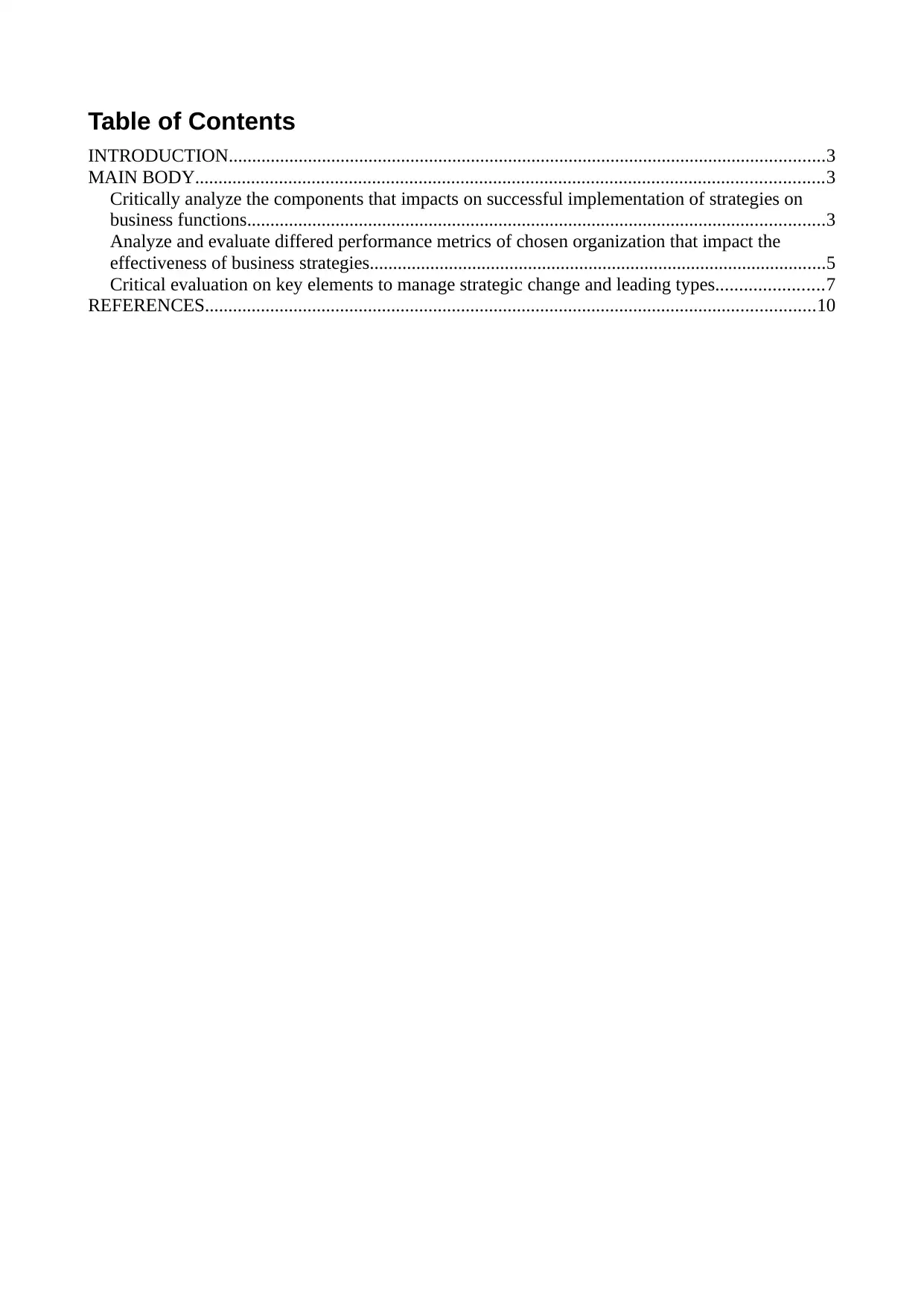
Table of Contents
INTRODUCTION................................................................................................................................3
MAIN BODY.......................................................................................................................................3
Critically analyze the components that impacts on successful implementation of strategies on
business functions............................................................................................................................3
Analyze and evaluate differed performance metrics of chosen organization that impact the
effectiveness of business strategies..................................................................................................5
Critical evaluation on key elements to manage strategic change and leading types.......................7
REFERENCES...................................................................................................................................10
INTRODUCTION................................................................................................................................3
MAIN BODY.......................................................................................................................................3
Critically analyze the components that impacts on successful implementation of strategies on
business functions............................................................................................................................3
Analyze and evaluate differed performance metrics of chosen organization that impact the
effectiveness of business strategies..................................................................................................5
Critical evaluation on key elements to manage strategic change and leading types.......................7
REFERENCES...................................................................................................................................10
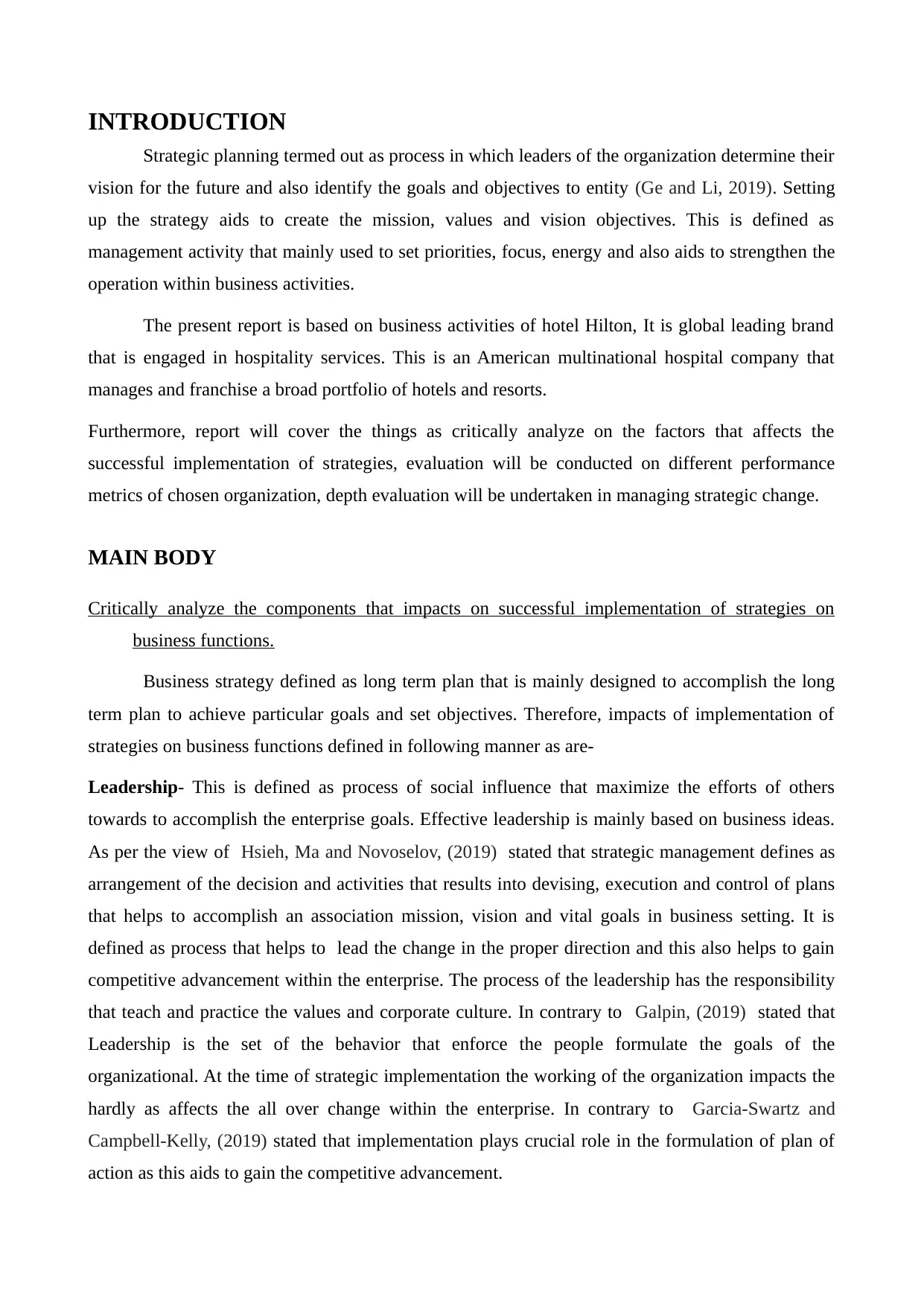
INTRODUCTION
Strategic planning termed out as process in which leaders of the organization determine their
vision for the future and also identify the goals and objectives to entity (Ge and Li, 2019). Setting
up the strategy aids to create the mission, values and vision objectives. This is defined as
management activity that mainly used to set priorities, focus, energy and also aids to strengthen the
operation within business activities.
The present report is based on business activities of hotel Hilton, It is global leading brand
that is engaged in hospitality services. This is an American multinational hospital company that
manages and franchise a broad portfolio of hotels and resorts.
Furthermore, report will cover the things as critically analyze on the factors that affects the
successful implementation of strategies, evaluation will be conducted on different performance
metrics of chosen organization, depth evaluation will be undertaken in managing strategic change.
MAIN BODY
Critically analyze the components that impacts on successful implementation of strategies on
business functions.
Business strategy defined as long term plan that is mainly designed to accomplish the long
term plan to achieve particular goals and set objectives. Therefore, impacts of implementation of
strategies on business functions defined in following manner as are-
Leadership- This is defined as process of social influence that maximize the efforts of others
towards to accomplish the enterprise goals. Effective leadership is mainly based on business ideas.
As per the view of Hsieh, Ma and Novoselov, (2019) stated that strategic management defines as
arrangement of the decision and activities that results into devising, execution and control of plans
that helps to accomplish an association mission, vision and vital goals in business setting. It is
defined as process that helps to lead the change in the proper direction and this also helps to gain
competitive advancement within the enterprise. The process of the leadership has the responsibility
that teach and practice the values and corporate culture. In contrary to Galpin, (2019) stated that
Leadership is the set of the behavior that enforce the people formulate the goals of the
organizational. At the time of strategic implementation the working of the organization impacts the
hardly as affects the all over change within the enterprise. In contrary to Garcia-Swartz and
Campbell-Kelly, (2019) stated that implementation plays crucial role in the formulation of plan of
action as this aids to gain the competitive advancement.
Strategic planning termed out as process in which leaders of the organization determine their
vision for the future and also identify the goals and objectives to entity (Ge and Li, 2019). Setting
up the strategy aids to create the mission, values and vision objectives. This is defined as
management activity that mainly used to set priorities, focus, energy and also aids to strengthen the
operation within business activities.
The present report is based on business activities of hotel Hilton, It is global leading brand
that is engaged in hospitality services. This is an American multinational hospital company that
manages and franchise a broad portfolio of hotels and resorts.
Furthermore, report will cover the things as critically analyze on the factors that affects the
successful implementation of strategies, evaluation will be conducted on different performance
metrics of chosen organization, depth evaluation will be undertaken in managing strategic change.
MAIN BODY
Critically analyze the components that impacts on successful implementation of strategies on
business functions.
Business strategy defined as long term plan that is mainly designed to accomplish the long
term plan to achieve particular goals and set objectives. Therefore, impacts of implementation of
strategies on business functions defined in following manner as are-
Leadership- This is defined as process of social influence that maximize the efforts of others
towards to accomplish the enterprise goals. Effective leadership is mainly based on business ideas.
As per the view of Hsieh, Ma and Novoselov, (2019) stated that strategic management defines as
arrangement of the decision and activities that results into devising, execution and control of plans
that helps to accomplish an association mission, vision and vital goals in business setting. It is
defined as process that helps to lead the change in the proper direction and this also helps to gain
competitive advancement within the enterprise. The process of the leadership has the responsibility
that teach and practice the values and corporate culture. In contrary to Galpin, (2019) stated that
Leadership is the set of the behavior that enforce the people formulate the goals of the
organizational. At the time of strategic implementation the working of the organization impacts the
hardly as affects the all over change within the enterprise. In contrary to Garcia-Swartz and
Campbell-Kelly, (2019) stated that implementation plays crucial role in the formulation of plan of
action as this aids to gain the competitive advancement.
⊘ This is a preview!⊘
Do you want full access?
Subscribe today to unlock all pages.

Trusted by 1+ million students worldwide
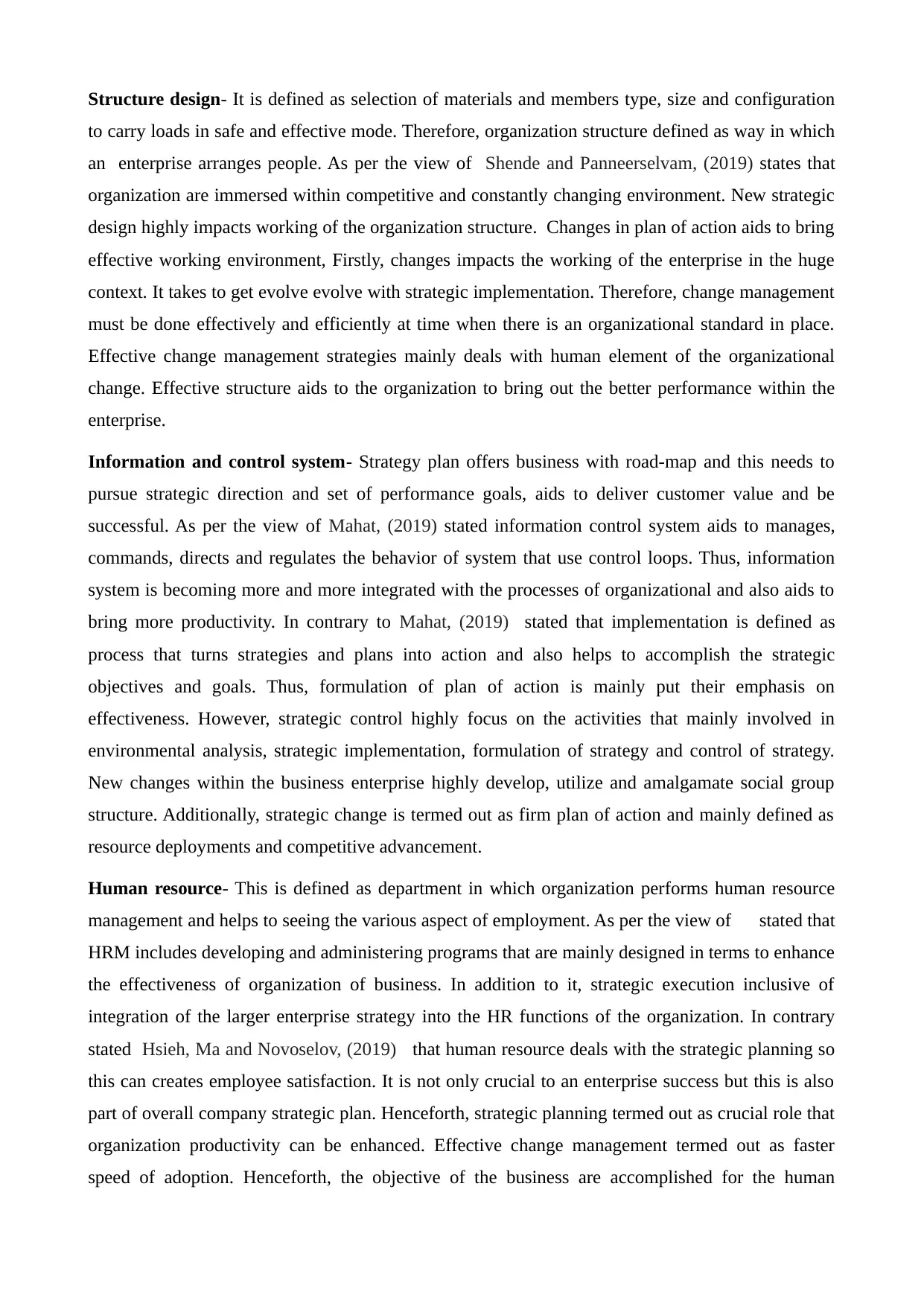
Structure design- It is defined as selection of materials and members type, size and configuration
to carry loads in safe and effective mode. Therefore, organization structure defined as way in which
an enterprise arranges people. As per the view of Shende and Panneerselvam, (2019) states that
organization are immersed within competitive and constantly changing environment. New strategic
design highly impacts working of the organization structure. Changes in plan of action aids to bring
effective working environment, Firstly, changes impacts the working of the enterprise in the huge
context. It takes to get evolve evolve with strategic implementation. Therefore, change management
must be done effectively and efficiently at time when there is an organizational standard in place.
Effective change management strategies mainly deals with human element of the organizational
change. Effective structure aids to the organization to bring out the better performance within the
enterprise.
Information and control system- Strategy plan offers business with road-map and this needs to
pursue strategic direction and set of performance goals, aids to deliver customer value and be
successful. As per the view of Mahat, (2019) stated information control system aids to manages,
commands, directs and regulates the behavior of system that use control loops. Thus, information
system is becoming more and more integrated with the processes of organizational and also aids to
bring more productivity. In contrary to Mahat, (2019) stated that implementation is defined as
process that turns strategies and plans into action and also helps to accomplish the strategic
objectives and goals. Thus, formulation of plan of action is mainly put their emphasis on
effectiveness. However, strategic control highly focus on the activities that mainly involved in
environmental analysis, strategic implementation, formulation of strategy and control of strategy.
New changes within the business enterprise highly develop, utilize and amalgamate social group
structure. Additionally, strategic change is termed out as firm plan of action and mainly defined as
resource deployments and competitive advancement.
Human resource- This is defined as department in which organization performs human resource
management and helps to seeing the various aspect of employment. As per the view of stated that
HRM includes developing and administering programs that are mainly designed in terms to enhance
the effectiveness of organization of business. In addition to it, strategic execution inclusive of
integration of the larger enterprise strategy into the HR functions of the organization. In contrary
stated Hsieh, Ma and Novoselov, (2019) that human resource deals with the strategic planning so
this can creates employee satisfaction. It is not only crucial to an enterprise success but this is also
part of overall company strategic plan. Henceforth, strategic planning termed out as crucial role that
organization productivity can be enhanced. Effective change management termed out as faster
speed of adoption. Henceforth, the objective of the business are accomplished for the human
to carry loads in safe and effective mode. Therefore, organization structure defined as way in which
an enterprise arranges people. As per the view of Shende and Panneerselvam, (2019) states that
organization are immersed within competitive and constantly changing environment. New strategic
design highly impacts working of the organization structure. Changes in plan of action aids to bring
effective working environment, Firstly, changes impacts the working of the enterprise in the huge
context. It takes to get evolve evolve with strategic implementation. Therefore, change management
must be done effectively and efficiently at time when there is an organizational standard in place.
Effective change management strategies mainly deals with human element of the organizational
change. Effective structure aids to the organization to bring out the better performance within the
enterprise.
Information and control system- Strategy plan offers business with road-map and this needs to
pursue strategic direction and set of performance goals, aids to deliver customer value and be
successful. As per the view of Mahat, (2019) stated information control system aids to manages,
commands, directs and regulates the behavior of system that use control loops. Thus, information
system is becoming more and more integrated with the processes of organizational and also aids to
bring more productivity. In contrary to Mahat, (2019) stated that implementation is defined as
process that turns strategies and plans into action and also helps to accomplish the strategic
objectives and goals. Thus, formulation of plan of action is mainly put their emphasis on
effectiveness. However, strategic control highly focus on the activities that mainly involved in
environmental analysis, strategic implementation, formulation of strategy and control of strategy.
New changes within the business enterprise highly develop, utilize and amalgamate social group
structure. Additionally, strategic change is termed out as firm plan of action and mainly defined as
resource deployments and competitive advancement.
Human resource- This is defined as department in which organization performs human resource
management and helps to seeing the various aspect of employment. As per the view of stated that
HRM includes developing and administering programs that are mainly designed in terms to enhance
the effectiveness of organization of business. In addition to it, strategic execution inclusive of
integration of the larger enterprise strategy into the HR functions of the organization. In contrary
stated Hsieh, Ma and Novoselov, (2019) that human resource deals with the strategic planning so
this can creates employee satisfaction. It is not only crucial to an enterprise success but this is also
part of overall company strategic plan. Henceforth, strategic planning termed out as crucial role that
organization productivity can be enhanced. Effective change management termed out as faster
speed of adoption. Henceforth, the objective of the business are accomplished for the human
Paraphrase This Document
Need a fresh take? Get an instant paraphrase of this document with our AI Paraphraser
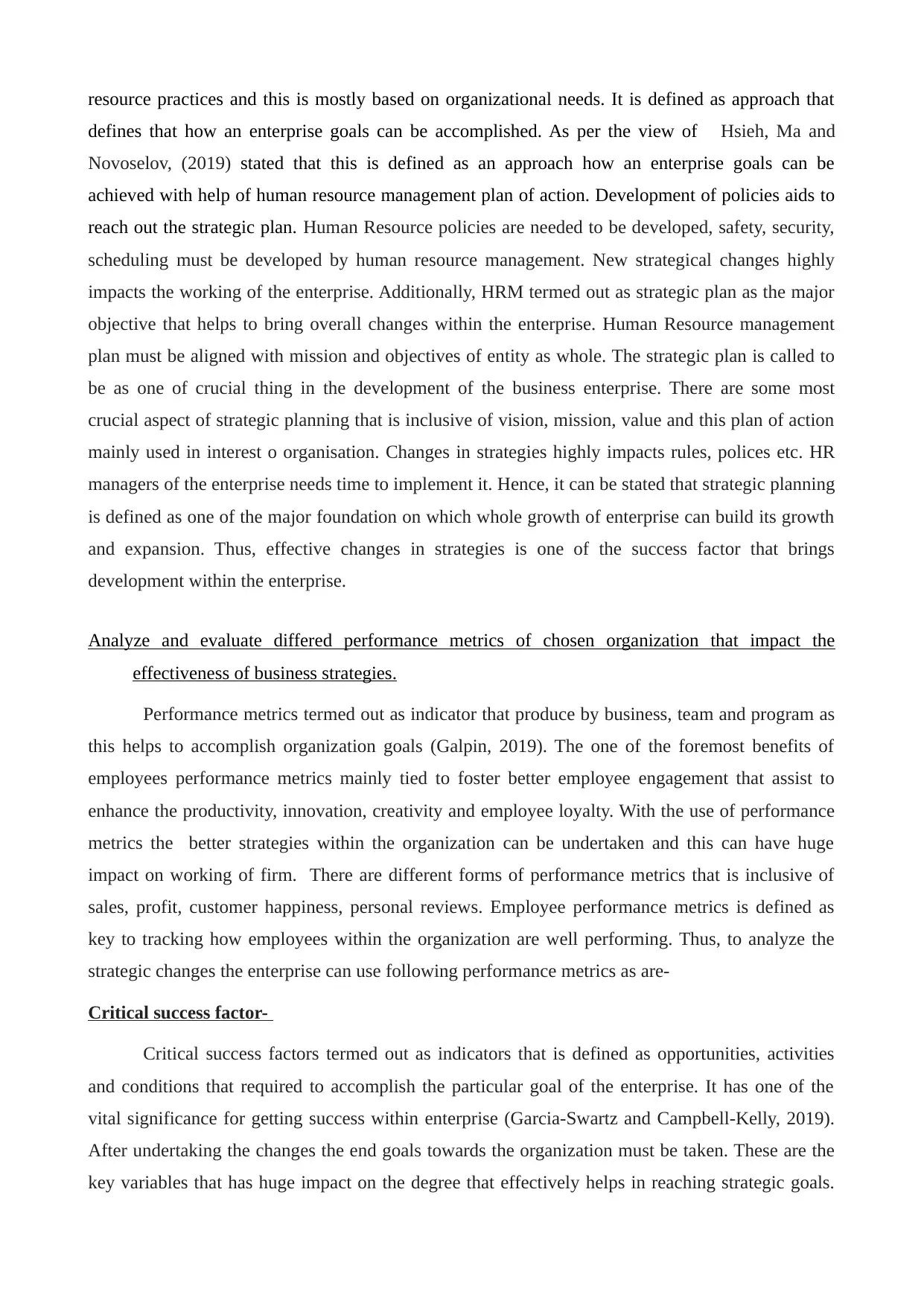
resource practices and this is mostly based on organizational needs. It is defined as approach that
defines that how an enterprise goals can be accomplished. As per the view of Hsieh, Ma and
Novoselov, (2019) stated that this is defined as an approach how an enterprise goals can be
achieved with help of human resource management plan of action. Development of policies aids to
reach out the strategic plan. Human Resource policies are needed to be developed, safety, security,
scheduling must be developed by human resource management. New strategical changes highly
impacts the working of the enterprise. Additionally, HRM termed out as strategic plan as the major
objective that helps to bring overall changes within the enterprise. Human Resource management
plan must be aligned with mission and objectives of entity as whole. The strategic plan is called to
be as one of crucial thing in the development of the business enterprise. There are some most
crucial aspect of strategic planning that is inclusive of vision, mission, value and this plan of action
mainly used in interest o organisation. Changes in strategies highly impacts rules, polices etc. HR
managers of the enterprise needs time to implement it. Hence, it can be stated that strategic planning
is defined as one of the major foundation on which whole growth of enterprise can build its growth
and expansion. Thus, effective changes in strategies is one of the success factor that brings
development within the enterprise.
Analyze and evaluate differed performance metrics of chosen organization that impact the
effectiveness of business strategies.
Performance metrics termed out as indicator that produce by business, team and program as
this helps to accomplish organization goals (Galpin, 2019). The one of the foremost benefits of
employees performance metrics mainly tied to foster better employee engagement that assist to
enhance the productivity, innovation, creativity and employee loyalty. With the use of performance
metrics the better strategies within the organization can be undertaken and this can have huge
impact on working of firm. There are different forms of performance metrics that is inclusive of
sales, profit, customer happiness, personal reviews. Employee performance metrics is defined as
key to tracking how employees within the organization are well performing. Thus, to analyze the
strategic changes the enterprise can use following performance metrics as are-
Critical success factor-
Critical success factors termed out as indicators that is defined as opportunities, activities
and conditions that required to accomplish the particular goal of the enterprise. It has one of the
vital significance for getting success within enterprise (Garcia-Swartz and Campbell-Kelly, 2019).
After undertaking the changes the end goals towards the organization must be taken. These are the
key variables that has huge impact on the degree that effectively helps in reaching strategic goals.
defines that how an enterprise goals can be accomplished. As per the view of Hsieh, Ma and
Novoselov, (2019) stated that this is defined as an approach how an enterprise goals can be
achieved with help of human resource management plan of action. Development of policies aids to
reach out the strategic plan. Human Resource policies are needed to be developed, safety, security,
scheduling must be developed by human resource management. New strategical changes highly
impacts the working of the enterprise. Additionally, HRM termed out as strategic plan as the major
objective that helps to bring overall changes within the enterprise. Human Resource management
plan must be aligned with mission and objectives of entity as whole. The strategic plan is called to
be as one of crucial thing in the development of the business enterprise. There are some most
crucial aspect of strategic planning that is inclusive of vision, mission, value and this plan of action
mainly used in interest o organisation. Changes in strategies highly impacts rules, polices etc. HR
managers of the enterprise needs time to implement it. Hence, it can be stated that strategic planning
is defined as one of the major foundation on which whole growth of enterprise can build its growth
and expansion. Thus, effective changes in strategies is one of the success factor that brings
development within the enterprise.
Analyze and evaluate differed performance metrics of chosen organization that impact the
effectiveness of business strategies.
Performance metrics termed out as indicator that produce by business, team and program as
this helps to accomplish organization goals (Galpin, 2019). The one of the foremost benefits of
employees performance metrics mainly tied to foster better employee engagement that assist to
enhance the productivity, innovation, creativity and employee loyalty. With the use of performance
metrics the better strategies within the organization can be undertaken and this can have huge
impact on working of firm. There are different forms of performance metrics that is inclusive of
sales, profit, customer happiness, personal reviews. Employee performance metrics is defined as
key to tracking how employees within the organization are well performing. Thus, to analyze the
strategic changes the enterprise can use following performance metrics as are-
Critical success factor-
Critical success factors termed out as indicators that is defined as opportunities, activities
and conditions that required to accomplish the particular goal of the enterprise. It has one of the
vital significance for getting success within enterprise (Garcia-Swartz and Campbell-Kelly, 2019).
After undertaking the changes the end goals towards the organization must be taken. These are the
key variables that has huge impact on the degree that effectively helps in reaching strategic goals.
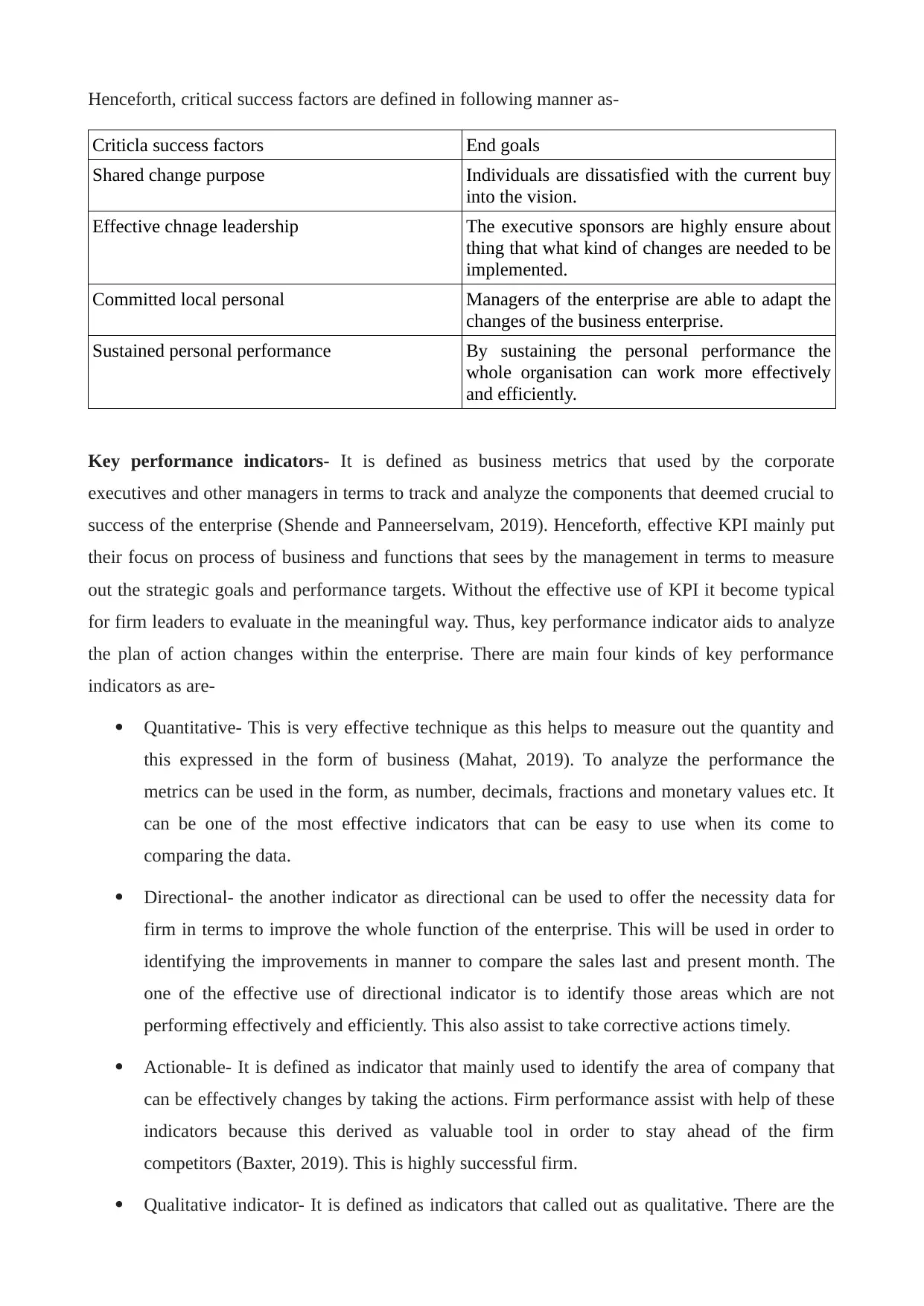
Henceforth, critical success factors are defined in following manner as-
Criticla success factors End goals
Shared change purpose Individuals are dissatisfied with the current buy
into the vision.
Effective chnage leadership The executive sponsors are highly ensure about
thing that what kind of changes are needed to be
implemented.
Committed local personal Managers of the enterprise are able to adapt the
changes of the business enterprise.
Sustained personal performance By sustaining the personal performance the
whole organisation can work more effectively
and efficiently.
Key performance indicators- It is defined as business metrics that used by the corporate
executives and other managers in terms to track and analyze the components that deemed crucial to
success of the enterprise (Shende and Panneerselvam, 2019). Henceforth, effective KPI mainly put
their focus on process of business and functions that sees by the management in terms to measure
out the strategic goals and performance targets. Without the effective use of KPI it become typical
for firm leaders to evaluate in the meaningful way. Thus, key performance indicator aids to analyze
the plan of action changes within the enterprise. There are main four kinds of key performance
indicators as are-
Quantitative- This is very effective technique as this helps to measure out the quantity and
this expressed in the form of business (Mahat, 2019). To analyze the performance the
metrics can be used in the form, as number, decimals, fractions and monetary values etc. It
can be one of the most effective indicators that can be easy to use when its come to
comparing the data.
Directional- the another indicator as directional can be used to offer the necessity data for
firm in terms to improve the whole function of the enterprise. This will be used in order to
identifying the improvements in manner to compare the sales last and present month. The
one of the effective use of directional indicator is to identify those areas which are not
performing effectively and efficiently. This also assist to take corrective actions timely.
Actionable- It is defined as indicator that mainly used to identify the area of company that
can be effectively changes by taking the actions. Firm performance assist with help of these
indicators because this derived as valuable tool in order to stay ahead of the firm
competitors (Baxter, 2019). This is highly successful firm.
Qualitative indicator- It is defined as indicators that called out as qualitative. There are the
Criticla success factors End goals
Shared change purpose Individuals are dissatisfied with the current buy
into the vision.
Effective chnage leadership The executive sponsors are highly ensure about
thing that what kind of changes are needed to be
implemented.
Committed local personal Managers of the enterprise are able to adapt the
changes of the business enterprise.
Sustained personal performance By sustaining the personal performance the
whole organisation can work more effectively
and efficiently.
Key performance indicators- It is defined as business metrics that used by the corporate
executives and other managers in terms to track and analyze the components that deemed crucial to
success of the enterprise (Shende and Panneerselvam, 2019). Henceforth, effective KPI mainly put
their focus on process of business and functions that sees by the management in terms to measure
out the strategic goals and performance targets. Without the effective use of KPI it become typical
for firm leaders to evaluate in the meaningful way. Thus, key performance indicator aids to analyze
the plan of action changes within the enterprise. There are main four kinds of key performance
indicators as are-
Quantitative- This is very effective technique as this helps to measure out the quantity and
this expressed in the form of business (Mahat, 2019). To analyze the performance the
metrics can be used in the form, as number, decimals, fractions and monetary values etc. It
can be one of the most effective indicators that can be easy to use when its come to
comparing the data.
Directional- the another indicator as directional can be used to offer the necessity data for
firm in terms to improve the whole function of the enterprise. This will be used in order to
identifying the improvements in manner to compare the sales last and present month. The
one of the effective use of directional indicator is to identify those areas which are not
performing effectively and efficiently. This also assist to take corrective actions timely.
Actionable- It is defined as indicator that mainly used to identify the area of company that
can be effectively changes by taking the actions. Firm performance assist with help of these
indicators because this derived as valuable tool in order to stay ahead of the firm
competitors (Baxter, 2019). This is highly successful firm.
Qualitative indicator- It is defined as indicators that called out as qualitative. There are the
⊘ This is a preview!⊘
Do you want full access?
Subscribe today to unlock all pages.

Trusted by 1+ million students worldwide
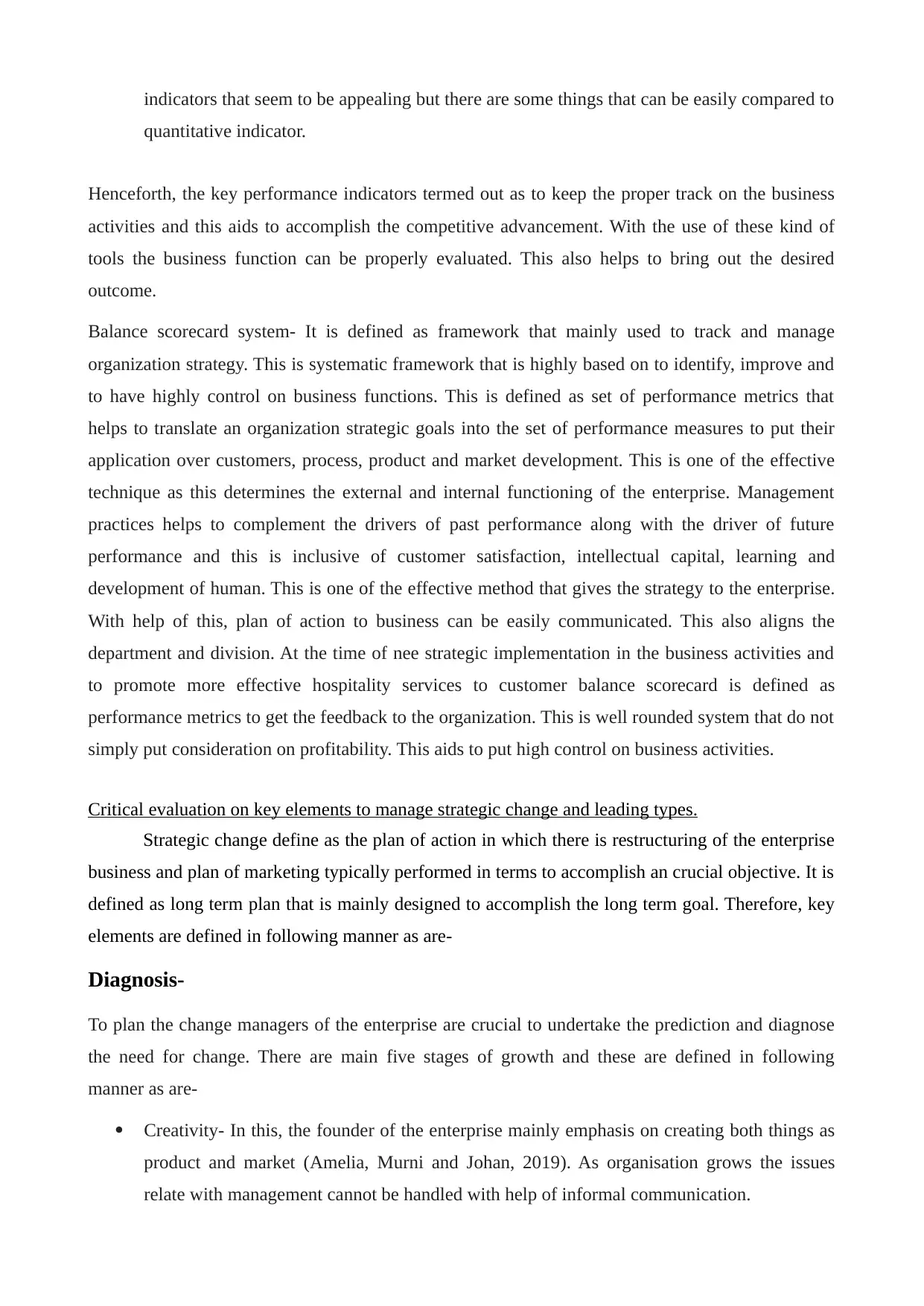
indicators that seem to be appealing but there are some things that can be easily compared to
quantitative indicator.
Henceforth, the key performance indicators termed out as to keep the proper track on the business
activities and this aids to accomplish the competitive advancement. With the use of these kind of
tools the business function can be properly evaluated. This also helps to bring out the desired
outcome.
Balance scorecard system- It is defined as framework that mainly used to track and manage
organization strategy. This is systematic framework that is highly based on to identify, improve and
to have highly control on business functions. This is defined as set of performance metrics that
helps to translate an organization strategic goals into the set of performance measures to put their
application over customers, process, product and market development. This is one of the effective
technique as this determines the external and internal functioning of the enterprise. Management
practices helps to complement the drivers of past performance along with the driver of future
performance and this is inclusive of customer satisfaction, intellectual capital, learning and
development of human. This is one of the effective method that gives the strategy to the enterprise.
With help of this, plan of action to business can be easily communicated. This also aligns the
department and division. At the time of nee strategic implementation in the business activities and
to promote more effective hospitality services to customer balance scorecard is defined as
performance metrics to get the feedback to the organization. This is well rounded system that do not
simply put consideration on profitability. This aids to put high control on business activities.
Critical evaluation on key elements to manage strategic change and leading types.
Strategic change define as the plan of action in which there is restructuring of the enterprise
business and plan of marketing typically performed in terms to accomplish an crucial objective. It is
defined as long term plan that is mainly designed to accomplish the long term goal. Therefore, key
elements are defined in following manner as are-
Diagnosis-
To plan the change managers of the enterprise are crucial to undertake the prediction and diagnose
the need for change. There are main five stages of growth and these are defined in following
manner as are-
Creativity- In this, the founder of the enterprise mainly emphasis on creating both things as
product and market (Amelia, Murni and Johan, 2019). As organisation grows the issues
relate with management cannot be handled with help of informal communication.
quantitative indicator.
Henceforth, the key performance indicators termed out as to keep the proper track on the business
activities and this aids to accomplish the competitive advancement. With the use of these kind of
tools the business function can be properly evaluated. This also helps to bring out the desired
outcome.
Balance scorecard system- It is defined as framework that mainly used to track and manage
organization strategy. This is systematic framework that is highly based on to identify, improve and
to have highly control on business functions. This is defined as set of performance metrics that
helps to translate an organization strategic goals into the set of performance measures to put their
application over customers, process, product and market development. This is one of the effective
technique as this determines the external and internal functioning of the enterprise. Management
practices helps to complement the drivers of past performance along with the driver of future
performance and this is inclusive of customer satisfaction, intellectual capital, learning and
development of human. This is one of the effective method that gives the strategy to the enterprise.
With help of this, plan of action to business can be easily communicated. This also aligns the
department and division. At the time of nee strategic implementation in the business activities and
to promote more effective hospitality services to customer balance scorecard is defined as
performance metrics to get the feedback to the organization. This is well rounded system that do not
simply put consideration on profitability. This aids to put high control on business activities.
Critical evaluation on key elements to manage strategic change and leading types.
Strategic change define as the plan of action in which there is restructuring of the enterprise
business and plan of marketing typically performed in terms to accomplish an crucial objective. It is
defined as long term plan that is mainly designed to accomplish the long term goal. Therefore, key
elements are defined in following manner as are-
Diagnosis-
To plan the change managers of the enterprise are crucial to undertake the prediction and diagnose
the need for change. There are main five stages of growth and these are defined in following
manner as are-
Creativity- In this, the founder of the enterprise mainly emphasis on creating both things as
product and market (Amelia, Murni and Johan, 2019). As organisation grows the issues
relate with management cannot be handled with help of informal communication.
Paraphrase This Document
Need a fresh take? Get an instant paraphrase of this document with our AI Paraphraser
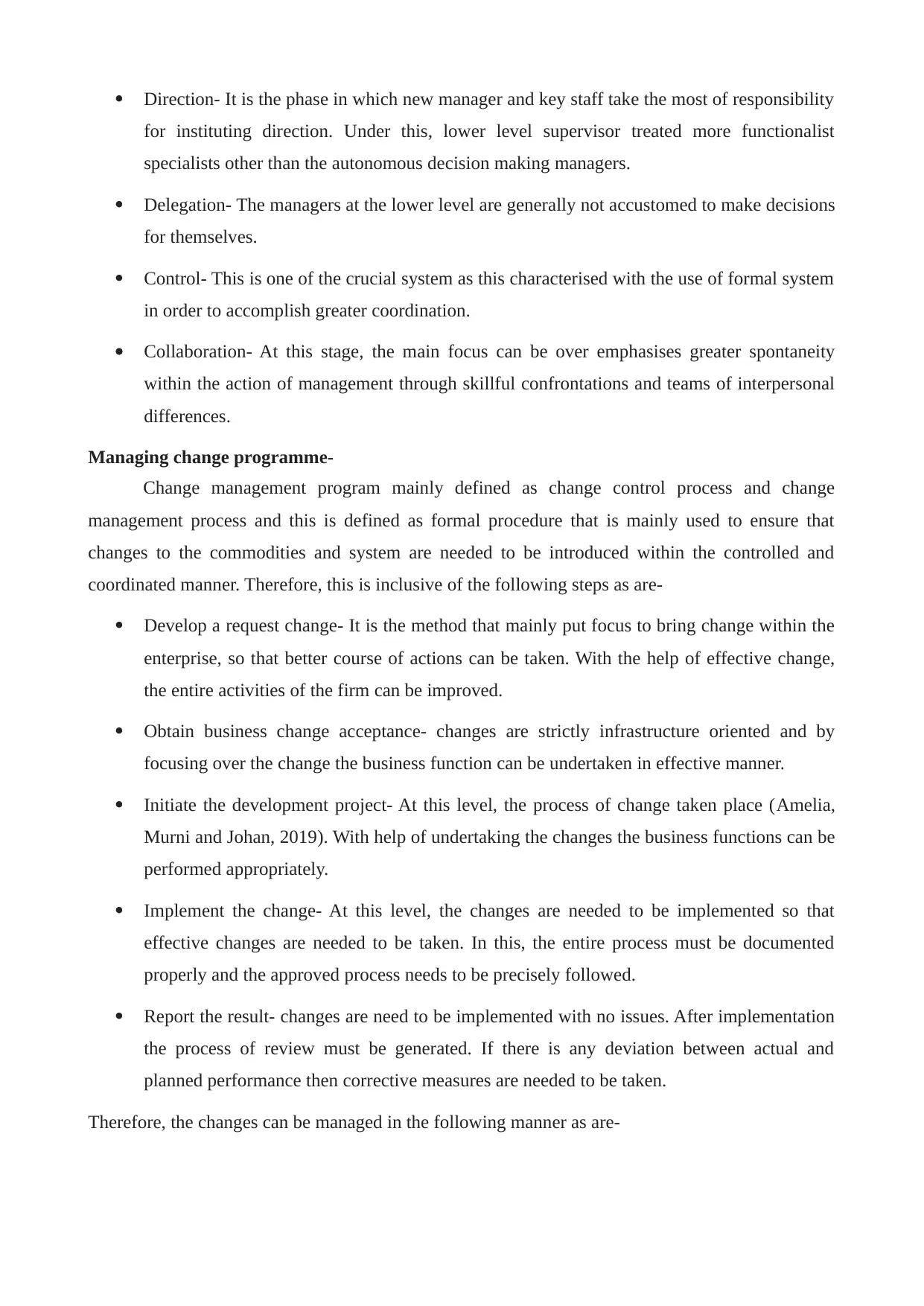
Direction- It is the phase in which new manager and key staff take the most of responsibility
for instituting direction. Under this, lower level supervisor treated more functionalist
specialists other than the autonomous decision making managers.
Delegation- The managers at the lower level are generally not accustomed to make decisions
for themselves.
Control- This is one of the crucial system as this characterised with the use of formal system
in order to accomplish greater coordination.
Collaboration- At this stage, the main focus can be over emphasises greater spontaneity
within the action of management through skillful confrontations and teams of interpersonal
differences.
Managing change programme-
Change management program mainly defined as change control process and change
management process and this is defined as formal procedure that is mainly used to ensure that
changes to the commodities and system are needed to be introduced within the controlled and
coordinated manner. Therefore, this is inclusive of the following steps as are-
Develop a request change- It is the method that mainly put focus to bring change within the
enterprise, so that better course of actions can be taken. With the help of effective change,
the entire activities of the firm can be improved.
Obtain business change acceptance- changes are strictly infrastructure oriented and by
focusing over the change the business function can be undertaken in effective manner.
Initiate the development project- At this level, the process of change taken place (Amelia,
Murni and Johan, 2019). With help of undertaking the changes the business functions can be
performed appropriately.
Implement the change- At this level, the changes are needed to be implemented so that
effective changes are needed to be taken. In this, the entire process must be documented
properly and the approved process needs to be precisely followed.
Report the result- changes are need to be implemented with no issues. After implementation
the process of review must be generated. If there is any deviation between actual and
planned performance then corrective measures are needed to be taken.
Therefore, the changes can be managed in the following manner as are-
for instituting direction. Under this, lower level supervisor treated more functionalist
specialists other than the autonomous decision making managers.
Delegation- The managers at the lower level are generally not accustomed to make decisions
for themselves.
Control- This is one of the crucial system as this characterised with the use of formal system
in order to accomplish greater coordination.
Collaboration- At this stage, the main focus can be over emphasises greater spontaneity
within the action of management through skillful confrontations and teams of interpersonal
differences.
Managing change programme-
Change management program mainly defined as change control process and change
management process and this is defined as formal procedure that is mainly used to ensure that
changes to the commodities and system are needed to be introduced within the controlled and
coordinated manner. Therefore, this is inclusive of the following steps as are-
Develop a request change- It is the method that mainly put focus to bring change within the
enterprise, so that better course of actions can be taken. With the help of effective change,
the entire activities of the firm can be improved.
Obtain business change acceptance- changes are strictly infrastructure oriented and by
focusing over the change the business function can be undertaken in effective manner.
Initiate the development project- At this level, the process of change taken place (Amelia,
Murni and Johan, 2019). With help of undertaking the changes the business functions can be
performed appropriately.
Implement the change- At this level, the changes are needed to be implemented so that
effective changes are needed to be taken. In this, the entire process must be documented
properly and the approved process needs to be precisely followed.
Report the result- changes are need to be implemented with no issues. After implementation
the process of review must be generated. If there is any deviation between actual and
planned performance then corrective measures are needed to be taken.
Therefore, the changes can be managed in the following manner as are-
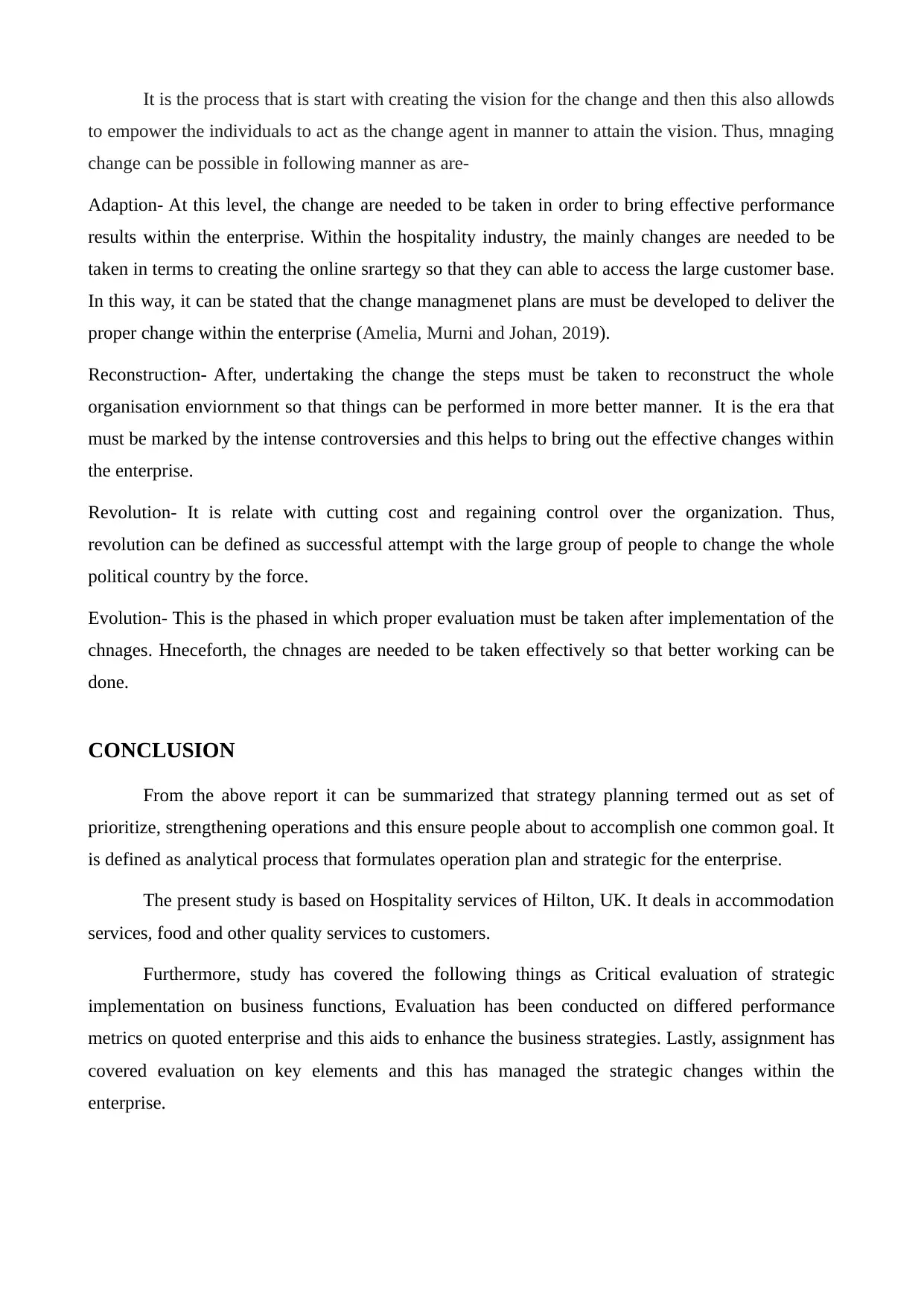
It is the process that is start with creating the vision for the change and then this also allowds
to empower the individuals to act as the change agent in manner to attain the vision. Thus, mnaging
change can be possible in following manner as are-
Adaption- At this level, the change are needed to be taken in order to bring effective performance
results within the enterprise. Within the hospitality industry, the mainly changes are needed to be
taken in terms to creating the online srartegy so that they can able to access the large customer base.
In this way, it can be stated that the change managmenet plans are must be developed to deliver the
proper change within the enterprise (Amelia, Murni and Johan, 2019).
Reconstruction- After, undertaking the change the steps must be taken to reconstruct the whole
organisation enviornment so that things can be performed in more better manner. It is the era that
must be marked by the intense controversies and this helps to bring out the effective changes within
the enterprise.
Revolution- It is relate with cutting cost and regaining control over the organization. Thus,
revolution can be defined as successful attempt with the large group of people to change the whole
political country by the force.
Evolution- This is the phased in which proper evaluation must be taken after implementation of the
chnages. Hneceforth, the chnages are needed to be taken effectively so that better working can be
done.
CONCLUSION
From the above report it can be summarized that strategy planning termed out as set of
prioritize, strengthening operations and this ensure people about to accomplish one common goal. It
is defined as analytical process that formulates operation plan and strategic for the enterprise.
The present study is based on Hospitality services of Hilton, UK. It deals in accommodation
services, food and other quality services to customers.
Furthermore, study has covered the following things as Critical evaluation of strategic
implementation on business functions, Evaluation has been conducted on differed performance
metrics on quoted enterprise and this aids to enhance the business strategies. Lastly, assignment has
covered evaluation on key elements and this has managed the strategic changes within the
enterprise.
to empower the individuals to act as the change agent in manner to attain the vision. Thus, mnaging
change can be possible in following manner as are-
Adaption- At this level, the change are needed to be taken in order to bring effective performance
results within the enterprise. Within the hospitality industry, the mainly changes are needed to be
taken in terms to creating the online srartegy so that they can able to access the large customer base.
In this way, it can be stated that the change managmenet plans are must be developed to deliver the
proper change within the enterprise (Amelia, Murni and Johan, 2019).
Reconstruction- After, undertaking the change the steps must be taken to reconstruct the whole
organisation enviornment so that things can be performed in more better manner. It is the era that
must be marked by the intense controversies and this helps to bring out the effective changes within
the enterprise.
Revolution- It is relate with cutting cost and regaining control over the organization. Thus,
revolution can be defined as successful attempt with the large group of people to change the whole
political country by the force.
Evolution- This is the phased in which proper evaluation must be taken after implementation of the
chnages. Hneceforth, the chnages are needed to be taken effectively so that better working can be
done.
CONCLUSION
From the above report it can be summarized that strategy planning termed out as set of
prioritize, strengthening operations and this ensure people about to accomplish one common goal. It
is defined as analytical process that formulates operation plan and strategic for the enterprise.
The present study is based on Hospitality services of Hilton, UK. It deals in accommodation
services, food and other quality services to customers.
Furthermore, study has covered the following things as Critical evaluation of strategic
implementation on business functions, Evaluation has been conducted on differed performance
metrics on quoted enterprise and this aids to enhance the business strategies. Lastly, assignment has
covered evaluation on key elements and this has managed the strategic changes within the
enterprise.
⊘ This is a preview!⊘
Do you want full access?
Subscribe today to unlock all pages.

Trusted by 1+ million students worldwide
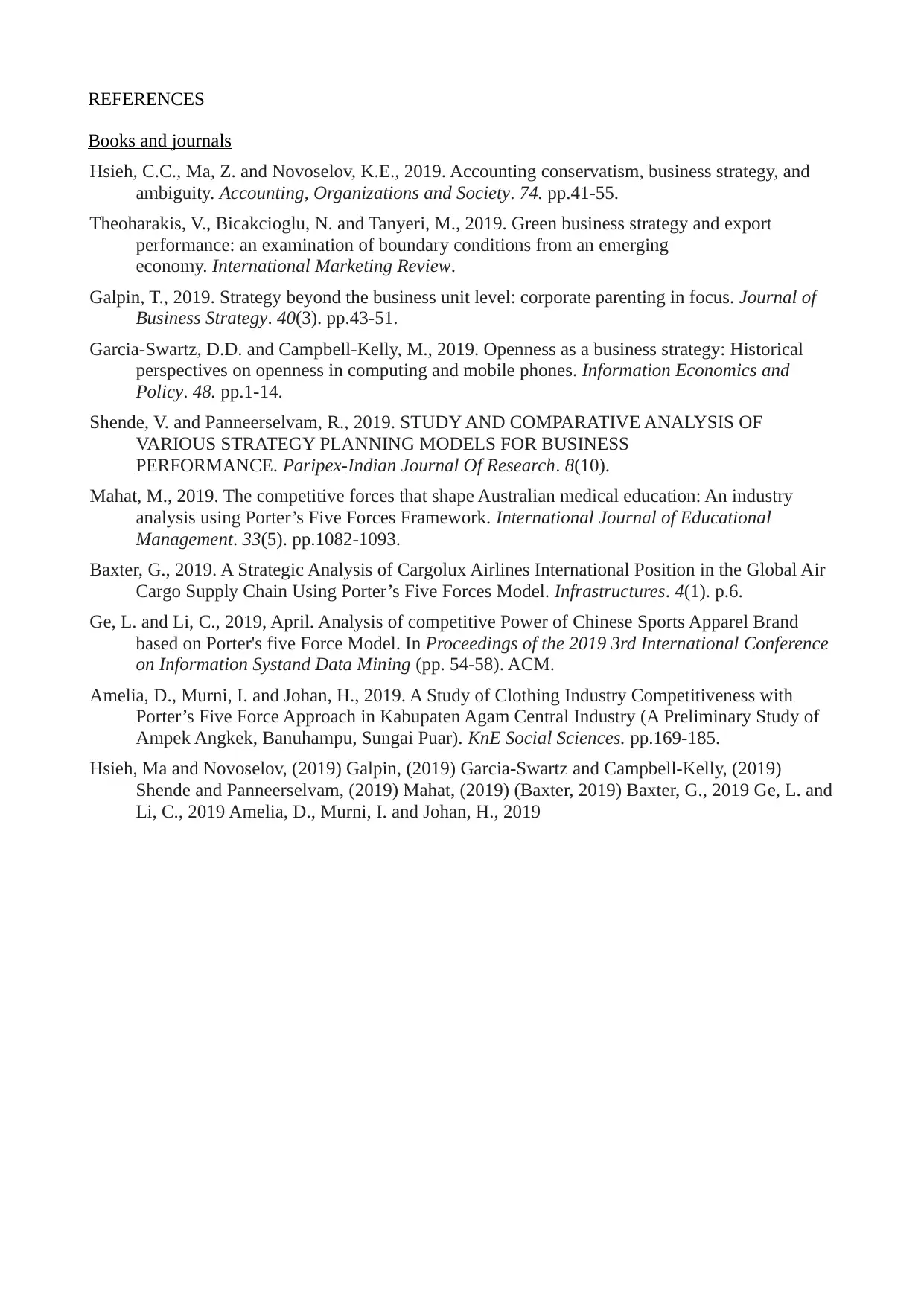
REFERENCES
Books and journals
Hsieh, C.C., Ma, Z. and Novoselov, K.E., 2019. Accounting conservatism, business strategy, and
ambiguity. Accounting, Organizations and Society. 74. pp.41-55.
Theoharakis, V., Bicakcioglu, N. and Tanyeri, M., 2019. Green business strategy and export
performance: an examination of boundary conditions from an emerging
economy. International Marketing Review.
Galpin, T., 2019. Strategy beyond the business unit level: corporate parenting in focus. Journal of
Business Strategy. 40(3). pp.43-51.
Garcia-Swartz, D.D. and Campbell-Kelly, M., 2019. Openness as a business strategy: Historical
perspectives on openness in computing and mobile phones. Information Economics and
Policy. 48. pp.1-14.
Shende, V. and Panneerselvam, R., 2019. STUDY AND COMPARATIVE ANALYSIS OF
VARIOUS STRATEGY PLANNING MODELS FOR BUSINESS
PERFORMANCE. Paripex-Indian Journal Of Research. 8(10).
Mahat, M., 2019. The competitive forces that shape Australian medical education: An industry
analysis using Porter’s Five Forces Framework. International Journal of Educational
Management. 33(5). pp.1082-1093.
Baxter, G., 2019. A Strategic Analysis of Cargolux Airlines International Position in the Global Air
Cargo Supply Chain Using Porter’s Five Forces Model. Infrastructures. 4(1). p.6.
Ge, L. and Li, C., 2019, April. Analysis of competitive Power of Chinese Sports Apparel Brand
based on Porter's five Force Model. In Proceedings of the 2019 3rd International Conference
on Information Systand Data Mining (pp. 54-58). ACM.
Amelia, D., Murni, I. and Johan, H., 2019. A Study of Clothing Industry Competitiveness with
Porter’s Five Force Approach in Kabupaten Agam Central Industry (A Preliminary Study of
Ampek Angkek, Banuhampu, Sungai Puar). KnE Social Sciences. pp.169-185.
Hsieh, Ma and Novoselov, (2019) Galpin, (2019) Garcia-Swartz and Campbell-Kelly, (2019)
Shende and Panneerselvam, (2019) Mahat, (2019) (Baxter, 2019) Baxter, G., 2019 Ge, L. and
Li, C., 2019 Amelia, D., Murni, I. and Johan, H., 2019
Books and journals
Hsieh, C.C., Ma, Z. and Novoselov, K.E., 2019. Accounting conservatism, business strategy, and
ambiguity. Accounting, Organizations and Society. 74. pp.41-55.
Theoharakis, V., Bicakcioglu, N. and Tanyeri, M., 2019. Green business strategy and export
performance: an examination of boundary conditions from an emerging
economy. International Marketing Review.
Galpin, T., 2019. Strategy beyond the business unit level: corporate parenting in focus. Journal of
Business Strategy. 40(3). pp.43-51.
Garcia-Swartz, D.D. and Campbell-Kelly, M., 2019. Openness as a business strategy: Historical
perspectives on openness in computing and mobile phones. Information Economics and
Policy. 48. pp.1-14.
Shende, V. and Panneerselvam, R., 2019. STUDY AND COMPARATIVE ANALYSIS OF
VARIOUS STRATEGY PLANNING MODELS FOR BUSINESS
PERFORMANCE. Paripex-Indian Journal Of Research. 8(10).
Mahat, M., 2019. The competitive forces that shape Australian medical education: An industry
analysis using Porter’s Five Forces Framework. International Journal of Educational
Management. 33(5). pp.1082-1093.
Baxter, G., 2019. A Strategic Analysis of Cargolux Airlines International Position in the Global Air
Cargo Supply Chain Using Porter’s Five Forces Model. Infrastructures. 4(1). p.6.
Ge, L. and Li, C., 2019, April. Analysis of competitive Power of Chinese Sports Apparel Brand
based on Porter's five Force Model. In Proceedings of the 2019 3rd International Conference
on Information Systand Data Mining (pp. 54-58). ACM.
Amelia, D., Murni, I. and Johan, H., 2019. A Study of Clothing Industry Competitiveness with
Porter’s Five Force Approach in Kabupaten Agam Central Industry (A Preliminary Study of
Ampek Angkek, Banuhampu, Sungai Puar). KnE Social Sciences. pp.169-185.
Hsieh, Ma and Novoselov, (2019) Galpin, (2019) Garcia-Swartz and Campbell-Kelly, (2019)
Shende and Panneerselvam, (2019) Mahat, (2019) (Baxter, 2019) Baxter, G., 2019 Ge, L. and
Li, C., 2019 Amelia, D., Murni, I. and Johan, H., 2019
1 out of 10
Related Documents
Your All-in-One AI-Powered Toolkit for Academic Success.
+13062052269
info@desklib.com
Available 24*7 on WhatsApp / Email
![[object Object]](/_next/static/media/star-bottom.7253800d.svg)
Unlock your academic potential
Copyright © 2020–2025 A2Z Services. All Rights Reserved. Developed and managed by ZUCOL.




